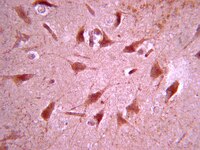Antibiotic treatment attenuates behavioral and neurochemical changes induced by exposure of rats to group a streptococcal antigen.
Lotan, D; Cunningham, M; Joel, D
PloS one
9
e101257
2014
显示摘要
Post-streptococcal A (GAS) sequelae including movement and neuropsychiatric disorders have been associated with improvement in response to antibiotic therapy. Besides eradication of infection, the underlying basis of attenuation of neuropsychiatric symptoms following antibiotic treatment is not known. The aim of the present study was to test the efficacy of antibiotic treatment in a rat model of GAS-related neuropsychiatric disorders. In the model, rats were not infected but were exposed to GAS-antigen or to adjuvants only (Control rats) and treated continuously with the antibiotic ampicillin in their drinking water from the first day of GAS-antigen exposure. Two additional groups of rats (GAS and Control) did not receive ampicillin in their drinking water. Behavior of the four groups was assessed in the forced swim, marble burying and food manipulation assays. We assessed levels of D1 and D2 dopamine receptors and tyrosine hydroxylase in the prefrontal cortex and striatum, and IgG deposition in the prefrontal cortex, striatum and thalamus. Ampicillin treatment prevented emergence of the motor and some of the behavioral alterations induced by GAS-antigen exposure, reduced IgG deposition in the thalamus of GAS-exposed rats, and tended to attenuate the increase in the level of TH and D1 and D2 receptors in their striatum, without concomitantly reducing the level of sera anti-GAS antibodies. Our results reinforce the link between exposure to GAS antigen, dysfunction of central dopaminergic pathways and motor and behavioral alterations. Our data further show that some of these deleterious effects can be attenuated by antibiotic treatment, and supports the latter's possible efficacy as a prophylactic treatment in GAS-related neuropsychiatric disorders. | 24979049
 |
Cell-type specific increases in female hamster nucleus accumbens spine density following female sexual experience.
Staffend, NA; Hedges, VL; Chemel, BR; Watts, VJ; Meisel, RL
Brain structure & function
219
2071-81
2014
显示摘要
Female sexual behavior is an established model of a naturally motivated behavior which is regulated by activity within the mesolimbic dopamine system. Repeated activation of the mesolimbic circuit by female sexual behavior elevates dopamine release and produces persistent postsynaptic alterations to dopamine D1 receptor signaling within the nucleus accumbens. Here we demonstrate that sexual experience in female Syrian hamsters significantly increases spine density and alters morphology selectively in D1 receptor-expressing medium spiny neurons within the nucleus accumbens core, with no corresponding change in dopamine receptor binding or protein expression. Our findings demonstrate that previous life experience with a naturally motivated behavior has the capacity to induce persistent structural alterations to the mesolimbic circuit that can increase reproductive success and are analogous to the persistent structural changes following repeated exposure to many drugs of abuse. | 23934655
 |
Adolescent changes in dopamine D1 receptor expression in orbitofrontal cortex and piriform cortex accompany an associative learning deficit.
Garske, AK; Lawyer, CR; Peterson, BM; Illig, KR
PloS one
8
e56191
2013
显示摘要
The orbitofrontal cortex (OFC) and piriform cortex are involved in encoding the predictive value of olfactory stimuli in rats, and neural responses to olfactory stimuli in these areas change as associations are learned. This experience-dependent plasticity mirrors task-related changes previously observed in mesocortical dopamine neurons, which have been implicated in learning the predictive value of cues. Although forms of associative learning can be found at all ages, cortical dopamine projections do not mature until after postnatal day 35 in the rat. We hypothesized that these changes in dopamine circuitry during the juvenile and adolescent periods would result in age-dependent differences in learning the predictive value of environmental cues. Using an odor-guided associative learning task, we found that adolescent rats learn the association between an odor and a palatable reward significantly more slowly than either juvenile or adult rats. Further, adolescent rats displayed greater distractibility during the task than either juvenile or adult rats. Using real-time quantitative PCR and immunohistochemical methods, we observed that the behavioral deficit in adolescence coincides with a significant increase in D1 dopamine receptor expression compared to juvenile rats in both the OFC and piriform cortex. Further, we found that both the slower learning and increased distractibility exhibited in adolescence could be alleviated by experience with the association task as a juvenile, or by an acute administration of a low dose of either the dopamine D1 receptor agonist SKF-38393 or the D2 receptor antagonist eticlopride. These results suggest that dopaminergic modulation of cortical function may be important for learning the predictive value of environmental stimuli, and that developmental changes in cortical dopaminergic circuitry may underlie age-related differences in associative learning. | 23437091
 |











